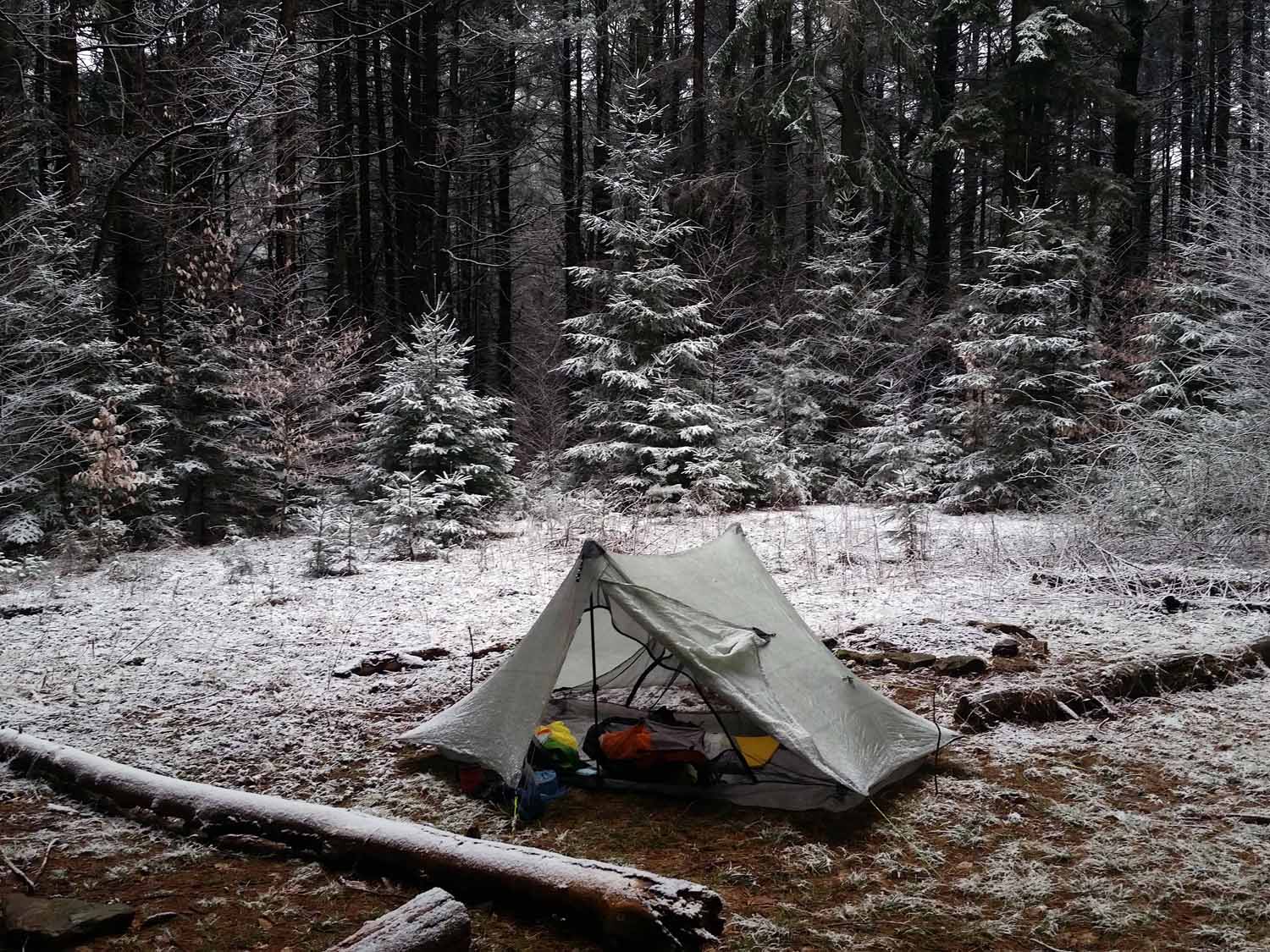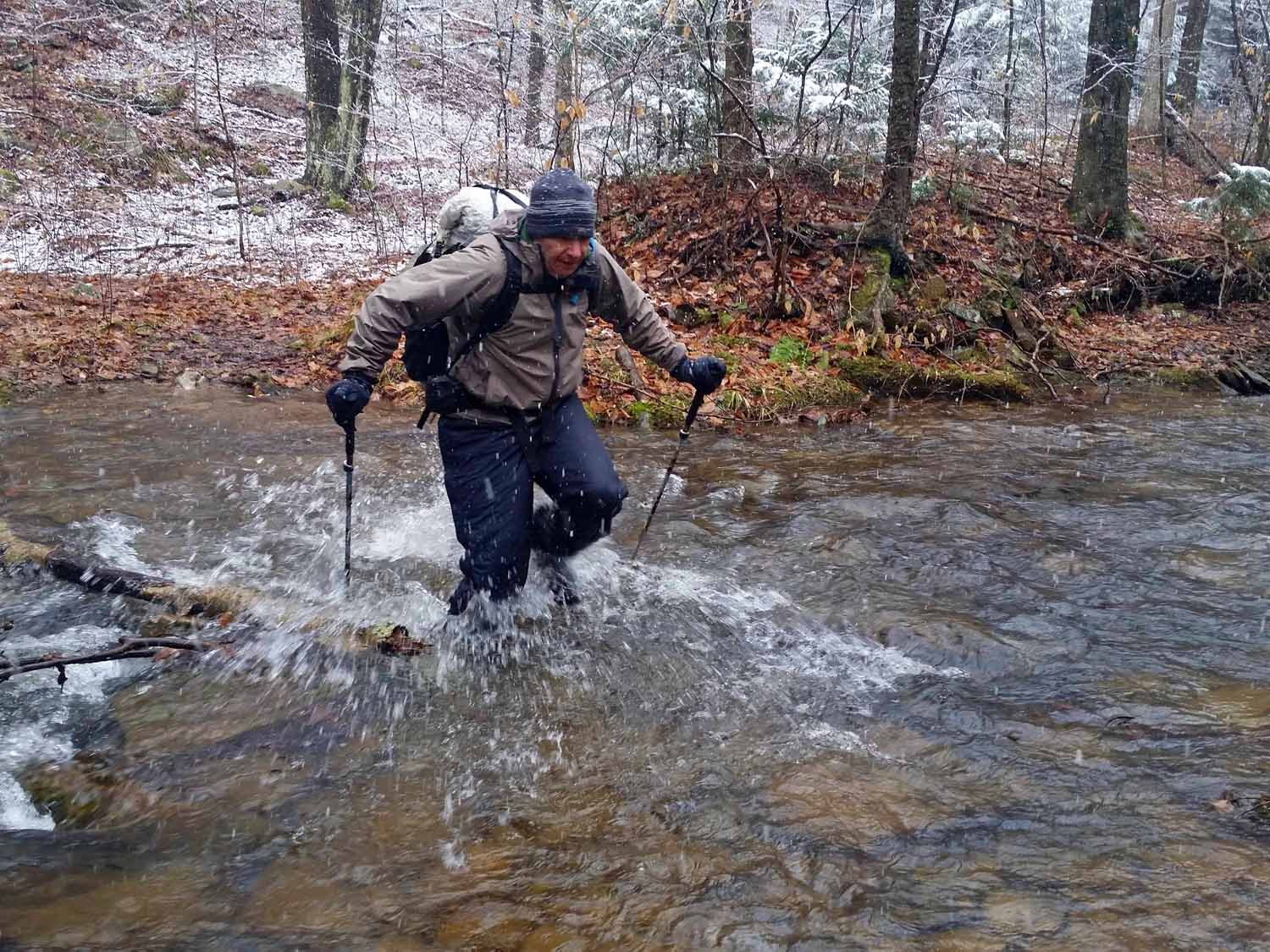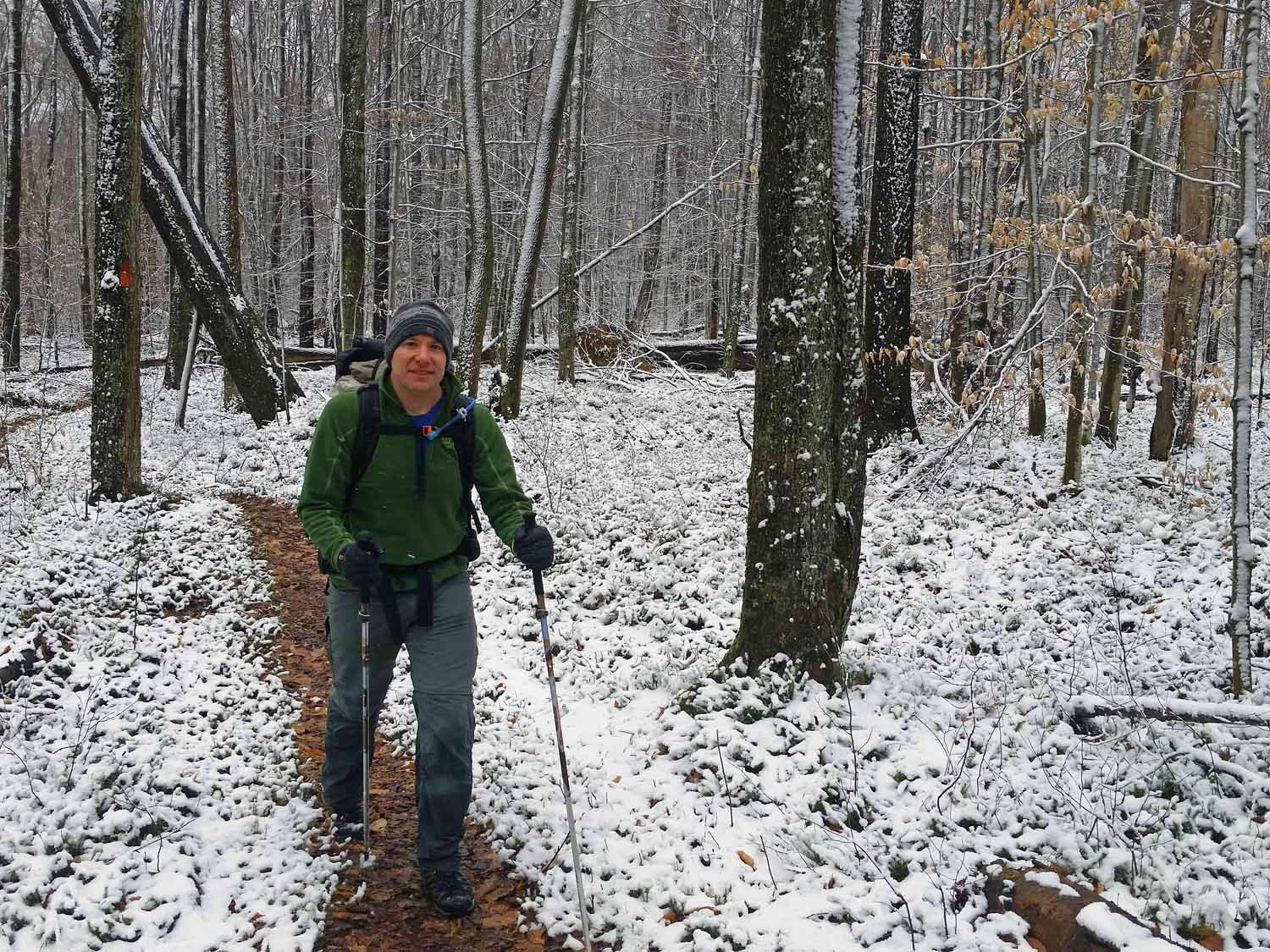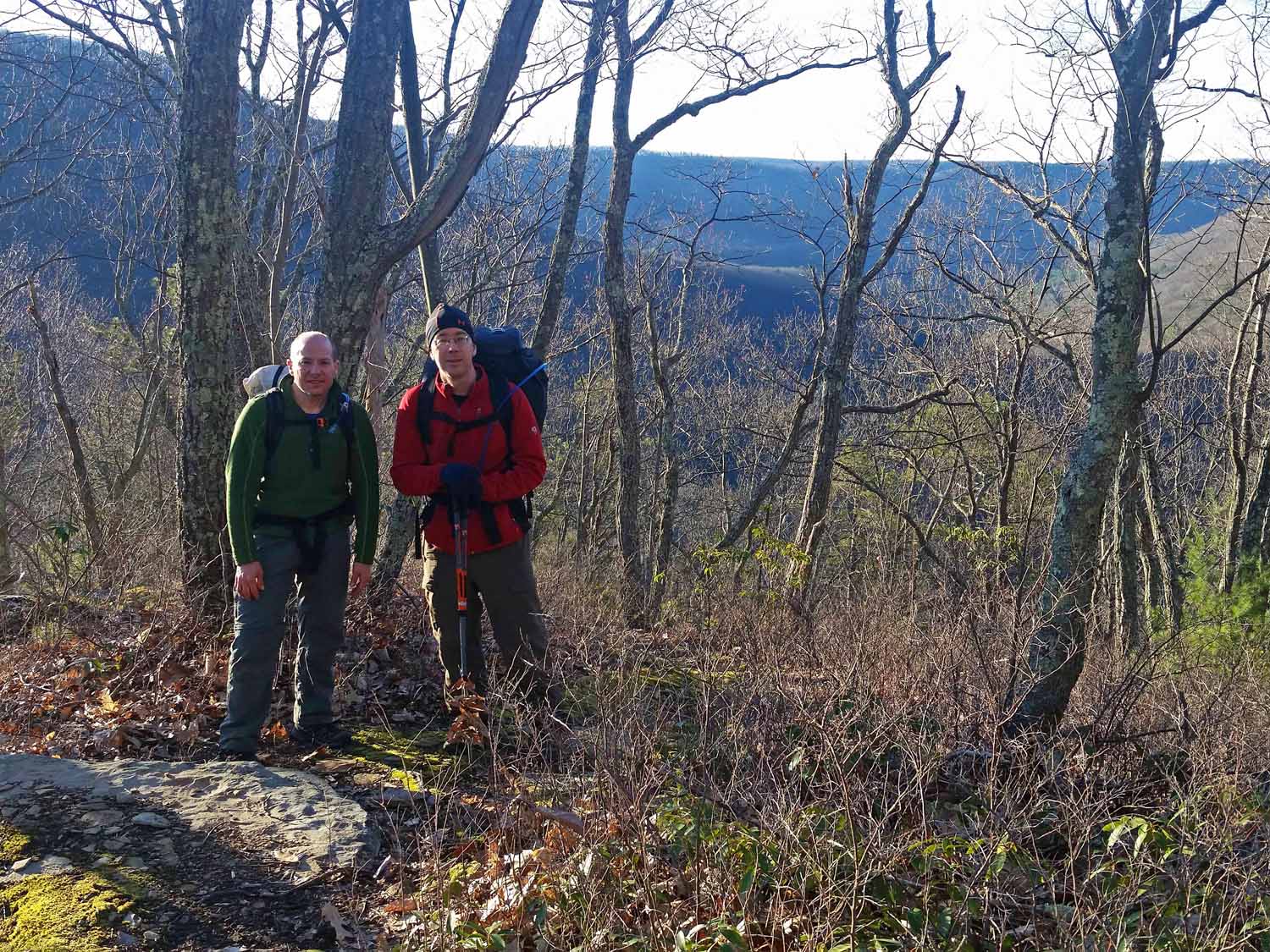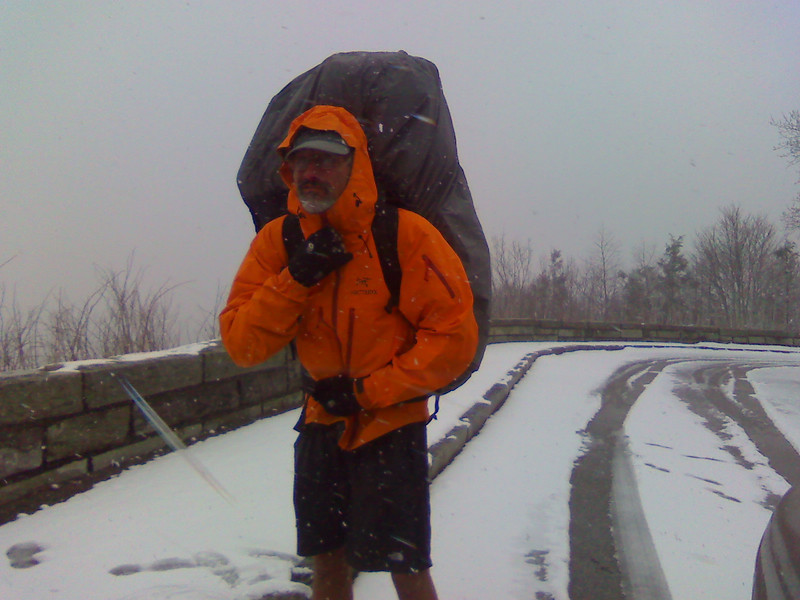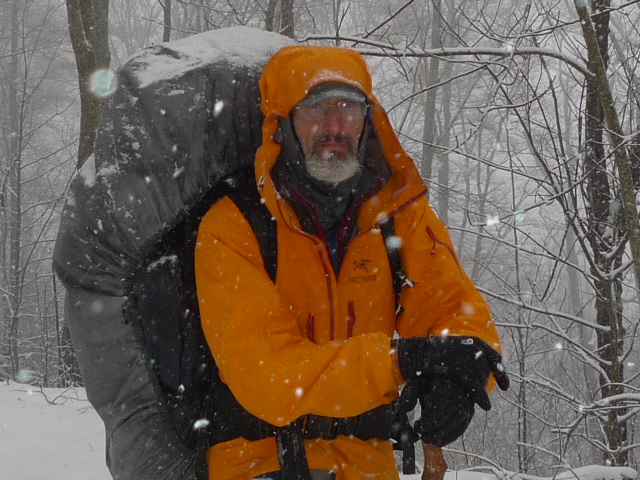Topic
Keeping dry in the rain
Forum Posting
A Membership is required to post in the forums. Login or become a member to post in the member forums!
Home › Forums › General Forums › Philosophy & Technique › Keeping dry in the rain
- This topic has 33 replies, 16 voices, and was last updated 7 years, 2 months ago by
 Todd Stough.
Todd Stough.
-
AuthorPosts
-
Nov 2, 2017 at 6:26 pm #3499892
I have some questions about keeping down and the inside of my tent dry in the rain. I use a Lunar Duo with a Tyvek footprint, a Thermorest Neoair Xlite and a down sleeping bag. Light backpacking, but not ultralight. I would appreciate comments on steps to take to minimize moisture inside the tent with the goal of keeping a down (sleeping bag and jacket) dry in particular.
Scenario 1: Its been raining steady, but not a torrential downpour all day as you have been hiking. Your clothes and pack are soaked, but you have a liner inside the pack so everything inside the pack (including tent) are dry. You are setting up camp in the open in the rain, without any cover. It will be raining all night. Temperatures are in the 40-55 degree range.
Q: What steps do you take to set up the tent, get out of wet clothes, get into dry clothes and air out wet stuff while minimizing wet sleeping bag and clothes in the morning.
Scenario 2: It is still raining in the morning and it is time to break down camp from scenario 1.
Q: What steps do you take to keep things dry and get ready for the day’s hike and setting up your tent at the next spot.
Thanks.
Nov 2, 2017 at 7:19 pm #3499920Have tent at top of pack. Quickly pull out and close pack up. Set up tent. Put pack and yourself in the tent. Make sure rain doesn’t drip off your wet stuff onto your dry stuff.
In the morning reverse.
Practice doing it, it is tricky. You have stated the problem very well.
Your down bag should have a cover that prevents rain drips or splash from getting into the bag.
Backpacking in the winter in the PNW, I encounter this regularly, although I try to time it when it’s not raining a lot.
If I get to camp, and rain is threatening, I make sure and put up tent before it starts raining. Once everything’s set up, it’s not that big a deal if it starts raining. In the morning if it’s raining, sleep for another hour or so before I finally give up and get up in the rain.
Can you leave 1/2 of your door open and the other side closed? Put wet gear like rain jacket under the closed door side so it drips onto ground? Operate your stove under the closed door. When you sleep, leave the open door still partially open for ventilation? If it’s real windy and rainy you have to close it completely.
Nov 2, 2017 at 10:10 pm #3499962Hi Ben,
I think we all have nightmares about getting our down sleeping bags wet. I will second Jerry’s recommendation on a dry-bag for your down sleeping bag as well as some backyard practice when it’s not raining. I use a Zpacks cuben dry-bag for my down sleeping bag; it may be overkill but I like knowing it is well protected. If my clothing is wet when I get in the tent while raining I’ve never had much luck getting anything to dry out much overnight especially if the rain continues.
I carry an 1/8 inch thick GG thin-light pad that I use as sit-pad during the day; I also use it to protect my thermarest xlite from punctures and to keep it from sliding around; but another way I use it is on top of my xlite to sandwich damp clothing between it and the xlite. My body heat at least keeps the damp clothing warm through the night. Maybe they dry out a little this way but I think the real benefit is that they are not both wet and cold when I put them on in the morning. If my clothing is really wet I might reverse the order with my xlite on top to protect my down bag more.
I currently use an MLD Solomid with an SMD Serenity net tent. I can setup the Solomid while it’s raining and get inside out of the rain before setting up the inner net tent which is nice. I like having this ability but it’s not a perfect solution. I still drag a lot of water in with me so I’ll use a bandana to mop up. The down bag only comes out when I have the place as dry as its going to get and the xlite is inflated. If it’s raining in the morning there is benefit in being able to pack up everything including the net tent while inside the Solomid. The Solomid gets hastily stuffed in the front mesh pocket of my pack.
lastly if I know it’s going to rain during my trip I carry a trekking umbrella. I always require a midnight bathroom visit and if it’s raining it worth it’s weight for that alone to me.
Andy
Nov 3, 2017 at 12:18 am #3499980What you describe is the situation that really puts your choice of shelter to the test, and IMO, where a 1-person shelter fails miserably. First you must be able to erect your shelter in the rain without the interior getting soaked…this eliminates most freestanding double-wall tents and leads us toward single-wall shelters. Second, the shelter must be large enough to get into while wet and still be able to keep 1/2 of it dry…this leads us to choosing a 2 person shelter. Rudy’s process is dead on and is exactly how I address this situation using a Duplex. A good camp towel is critical.
Another tactic You can employ when you know the weather will be bad is to accept the weight penalty of packing a small tarp that can be deployed as a porch. Pitch the tarp somewhat high and get under it. Unpack your tent and setup with the entrance door just under one edge of the tarp. ZPacks makes a 1.0 DCF 52”x90” groundsheet that when combined with 1.2mm z-line makes a great “porch tarp” setup for less than 5oz total.
Nov 3, 2017 at 6:25 am #3500021Carry half a square foot of pak-towel, wipe down the pad and inside of the tarp before deploying your sleeping bag, and then wring it out. You can get 90% of the liquid water off those surfaces that way.
And use it as a towel, hankie, and pot holder.
Nov 3, 2017 at 10:39 am #3500033Assuming you can get into your dry sleeping bag (++ for towels – I carry one for the tarptent and one for me), the challenge is keeping from getting wet during the night. I have never seen a tent which will stay dry in standing water, so site selection is critical. If the site drainage is less than adequate, ditching is necessary.
I am experimenting with carrying a 13 gallon trash bag (weighs less than 1 oz.) to slip over the bottom of my sleeping bag on wet nights. I have never gotten wet (or damp) except at the bottom of the bag.
Nov 3, 2017 at 11:19 am #3500037+1 to multiple towels. Everybody has their favorite…I’m currently liking the 12×24 LightLoad variety.
Certainly pitching your shelter in a low spot is to be avoided at all costs, but I’ve never had a problem with pooling water seeping through the floor of my tents…3 MSR Hubbas, Duplex, Tarptent Notch…they all have stayed dry. Perhaps I have just been lucky? Down here in the SE we get “toad strangler” thunderstorms that can dump water so quickly that it can’t runoff fast enough. Then the world just becomes one big, shallow puddle until the rainfall slows to something less than the runoff/percolation rate.
Nov 3, 2017 at 12:00 pm #3500039I know that overall scenario well, it is called hiking in two or three days of steady rain…
1) Others have covered tent erection and take down. I use a tarp. two stakes at the bottom end, one stake to pitch the pole, two stakes to pull it out. This works even in a wind. I want to note that yes, it will be wet.
2) I toss my pack under my tarp. I take care of other things: water, toilet duties, if it is cold, I get some smaller twigs, etc for a *small* fire under the tarp (even if they are soaked.) I throw a couple larger sticks under to use as poles for ventilation. Why a fire? Because, a heat source will change the humidity characteristics of the air significantly.
3) I crawl in and pull out my ground cloth. Opening this up about half way, I mop it off with a bandana, wringing it out as I go. I pull gear out of my pack next, laying out my pad, quilt, and all my dry gear. Then I strip and change into dry sleeping cloths, but leaving my dry sleeping socks off. Then I push out/mop/push out my ground cloth. I usually hang my pants and hiking shirt on my cloths line (already attached.) Then I prop up the lower end for cross ventilation. Then I am free to start my supper. This will add some heat inside and I use the wait time to dry out a few twigs by the stoves fire., carefully splitting them to get fine fire starters. Then I pour in my supper and set it aside to cook/cool. This takes about 1/2 hour, maybe 3/4 hour.
4) I peel back my ground cloth and lay out for a small fire. Maybe I have a few rocks thrown in, maybe it is mostly mineral soil, or maybe it is too wet to care. Then I start a small fire that requires almost constant feeding…like every 3-4 minutes. It is usually about 8″-12″ around. It produces some smoke, so I usually lay down when I do this. Usually, the tent acts as a tunnel and will blow most or all of the smoke out, though. Withing 5 minutes things start to dry. By the time supper is ready to eat, I am warm enough and the food is ready to eat. Raising the temp even degrees will really change the inside humidity of the air…things will dry easily, though not anything thoroughly.
5) It often is getting dark and under a tent/tarp it is worse, so after I eat and make my cocoa, I let the fire die out and sleep. Note that my rain jacket is handy for any midnight toilet runs.
6) Around dawn or something before light, I start making breakfast. I cuss for a minute ‘cuz it is still raining, I am slightly damp from retrieving the bear bag, feeling lazy and drink 3 cups of coffee. I change into my wet cloths, and pack up my dry gear/quilt and ground cloth (mopping as much water as I can.) I zap some water for the hike (I use a steripen) and empty my platy usually on the fire. Then I pack up everything except my tarp and pot. OK, time to bite the bullet…I crawl out and as fast as possible pull the tarp down and pack it into my pot, wringing/shaking as much water out of it as I can. I put this on top of my pack, I am ready to go. I kick the fire around to leave a fairly clean site, maybe grab a hand full or two of leaves/needles and cover it (stomping it down some.) I say good-bye and I am hiking.Note that hanging a bear bag can be a trick. You need to pull all food for the evening, then hang it. In the morning, it means a quick trip to retrieve it. Yup, it always means getting out in the rain.
Small fires require constant attention. I often break twigs to stack around the fire to help them dry. Wet ground will protect the ground from ground-fires, so I don’t usually worry about it. It is near the corner of my tarp (propped up) so it cannot be too big, anyway.
Nov 3, 2017 at 12:16 pm #3500041A lot of good info here, to which I would add:
Consider a synthetic (Apex) quilt or sleeping bag, have a dedicated set of dry long underwear to change into, and learn to embrace the suck.
It’s hardest IMO to change back into the wet stuff next morning, but it is a huge motivator to get up and get moving. Have a nice breakfast and coffee first, while still enjoying the dry warmth, then grit yer teeth and git ‘er done. Fifteen minutes later it won’t seem that bad, I promise. ;^)
Nov 3, 2017 at 12:24 pm #3500042…learn to embrace the suck.
Truer words have never been spoken.
Sitting here discussing this scenario and reading all the replies makes one wonder why anyone would ever choose to be out in such weather. But thinking back, those trips that included a serious weather challenge are some of the most fondly remembered…perhaps for having conquered them. I can’t be the only one to feel that way.
Nov 3, 2017 at 12:45 pm #3500043those trips with that included a serious weather challenge are some of the most fondly remembered…perhaps for having conquered them
Indeed.
Mark Cashmere, Ed Cooper and I will never forget the Black Forest Trail we did last spring, in April.
It went from cool drizzle, to rain and then finally snow and sleet. Perfect weather for the last evening’s camp and the hike out, naturally.



 Nov 3, 2017 at 12:51 pm #3500045
Nov 3, 2017 at 12:51 pm #3500045Precisely! And I will bet the word “awesome” is used by each of you whilst reminiscing about that trip :)
Nov 7, 2017 at 4:41 am #3500753Thanks for the insights! I like hearing about Northeast weather, too. It seems that everyone gets into their tents wet. I usually carry a microfiber towel.
Q: Do you keep the wet clothes outside in the vestibule to minimize water in the tent? The air will be pretty humid already from the rain. Also, since the tent is wet, I keep it in the mesh pocket of my Exos 58. Does anyone try to keep the tent dry after taking it down? Repack it in a stuff sack?
Ben.
Nov 7, 2017 at 12:21 pm #3500774I take two 1-2 week trips a year – one in April and one in September/October (I hate hiking in summer heat) and invariably there is rain – often several days in a row. I never really stay dry – everything gets somewhat damp. I also bring a small towel and bring a separate set of sleeping clothes that I try very hard to keep as dry as possible.
I do not often bother to hang the wet hiking clothes unless I am in something like an Adirondack lean-to (which is a fantastic place after a rainy day) – but the clothes don’t usually dry anyway. If it is going to be particularly cold at night I might put them in a plastic bag and keep them in the sleeping bag to stay warm – takes the edge off of putting on wet clothes in the morning. They often will mostly dry out under my rain shell as I hike the next day.
I like to tarp camp in the rain if I am in sheltered areas. I bring an 8×10 tarp that provides a lot of space for one person to move around, which is helpful when trying to keep wet stuff away from dry stuff.
The one thing I haven’t really found an answer to is maintaining a down bag over an extended period of wet weather. The bag never gets wet, other than maybe occasionally brushing up against condensation, but over a couple of days of yuck weather it loses some loft. And it always seems that a cold clear night follows the wet. I end up bringing a warmer (and heavier) bag than needed for the temps just to provide some margin for the wet.
But I actually love hiking in the rain – the woods often take on a mystical quality, and a rainy forecast is the best way to find solitude.
Dave
Nov 7, 2017 at 12:41 pm #3500781The bag never gets wet, other than maybe occasionally brushing up against condensation, but over a couple of days of yuck weather it loses some loft.
In periods of prolonged rainy weather, “dry” is a relative term.
But I actually love hiking in the rain – the woods often take on a mystical quality, and a rainy forecast is the best way to find solitude.
Amen.
Nov 7, 2017 at 2:17 pm #3500793I put wet rain jacket in the vestibule. Water drips onto the ground. It never dries out.
The next day if it quits raining, it’ll dry out wearing it in a couple hours.
My base layer shirt and pants dry out wearing them in the tent, after a couple hours of fiddling around, eating,…
Nov 18, 2017 at 3:59 am #3502731I grew up camping in PNW, and have a few tricks to keep gear dry.
Piece of Tyvek as a tarp above my tent during setup and take down if possible. Then setup as an A-frame tarp with my trekking poles to change clothes and hang wet stuff out of the rain, but with good air flow. I have a large vestibule now for changing/hanging (Big Agnes Copper Hotel), but will still bring a separate tarp if I have more gear.
Real game changer is being able to pitch the fly first. If you really want a dry tent, this is your best option. Not sure my is designed for this, but it is possible, and works well enough.
Bring a good towel. I have a packtowl original for drying the fly or whatever before it goes in my bag, and keep it in the tent just in case. absorbs a ton and wrings out well.
Make sure the fly is taught so condensation can run to the ground, and not to the tent.
I prefer to hike my clothes dry if possible, but will sleep them dry if its not too humid at night. Get used to wearing wet clothes while you are moving if its really coming down, but keep sleep clothes with your sleep system in a dry bag.
Treated down is legit. I don’t have it in my bag (FF), but will in my next quilt (EE), though never had an issue. All my clothing down is treated, and I love it. Never cold enough to wear down in the rain (cold enough for down means its snowing), but it does get wet from melt and sweat, and still keeps me warm. Also make sure the fabric has good water resistance.
Nov 18, 2017 at 5:38 pm #3502773A hammock solves it all. Tarp first of course, then the hammock and the rest of your gear. And you end up with a nice dry place to cook and a swinging easy chair while you sip your hot cocoa and watch the water drip off the edge of the “porch roof.” A square of Tyvek makes a good dressing mat.
With a tarp, it is tarp first, then ground sheet, and a bivy helps a lot. Wet muddy stuff gets put off where it can do the least damage — all compromise really. Pack towel? Yeah!
Nov 19, 2017 at 5:48 am #3502867The simplest way to keep things dry is to use 3 plasic bags.
- Clothing/mattress/other gear you want dry
- Food, I use oder resistant nylofume bags, are as tough as trash compactor bags
- Sleeping bag
When you get to camp take out the three bags, then take out your shelter and set it up. throw your clothes bag in your shelter and blow up your mattress, then change your clothes. Grab the bag with your sleeping bag, lay it on your mattress and climb in. Leave your food bag out next to your shelter and grab what you need when you need it.
Nov 19, 2017 at 7:29 am #3502874Even simpler:
Pack gear and food in plastic bags inside silnylon bags, and place in pack. They will all stay dry.
Do up (silnylon) pack throat.
Put wet tent on top of pack throat under pack lid (and strap it there!).Now you can pitch your tent without unpacking your pack.
Yes, wet gear stays in the vestibule. Strip off before you get right in. In our case if it is raining, Sue gets into tent as soon as possible with her pack in vestibule while I finish pitching the tent (guys etc) and find water. She starts arranging interior – mats etc.
Well, it works fine for us.
Cheers
Nov 19, 2017 at 5:03 pm #3502904You scenarios are typical for me but you left out a few important twists—like arriving to your potential camp with frozen wet hands now numb and wooden and almost impossible to use to do anything—like unclipping the hipbelt or setting up the tent. Why? Because it’s raining and 35F.
I call setting up camp fast as the “8 second rodeo ride”—go fast and hang on and get it done. Embrace the suck—as someone says. Made hellish when soaked at 35F in a high wind. You will get stage 1 hypothermia fumbling with the tent in a soaked state but once the tent is up you’ll survive once you strip naked and get into dry layers.
First priority is to get the tent up fast. Then lay out sleeping pad so you can sit down in the tent and reconfigure clothing. Then take off wet clothing and rain shells and put on dry clothing. Your shaking will stop in an hour. When I write in my trail journal my hand’s still shaking and it looks like the writing of a 95 year old.
On my last trip I got caught in a November sleetstorm on Day 10 of a 21 day trip and decided to pull a zero in my tent and avoid the mess. On Day 11 most of the cold rain ended and just a little sleet spat from the sky so I wanted to pack and keep hiking, which I did.

Here I am beginning an 18 day winter trip at my shuttled drop-off point in miserable weather. The whole point is to try and keep 90% of all my clothing layers dry and in the pack—and only wear minimal stuff which is allowed to get wet. The rain jacket saves my life on a daily basis—because it keeps me warm enough to not die while in hiking mode. With minimal layers underneath.

This was taken on the same trip with continuing crappy weather. I since upgraded to MLD eVent shell mittens to keep my fleece gloves dry . . . drier. They will wet out eventually which leads to wooden blocks for hands. Embrace the suck. And get your shelter up FAST.
Nov 19, 2017 at 8:30 pm #3502928Exactly what Tipi says.
A few details which we find help us:
* We can stay a lot warmer inside our ponchos as our arms are not ‘exposed’: they stay inside the poncho.
* Very light overmitts over light fleece gloves can be wonderful – even just silnylon shells will do. USE them.
* Know your real limits – this only comes with experience. It can’t be bought.
* Either keep going fast (generating heat) or stop and pitch camp – also fast.
* Really separate your wet travelling clothes from your dry warmth clothes.
* A simple canister stove and Instant Soup can be real luxury.Cheers
Nov 19, 2017 at 8:36 pm #3502929Or a thermos of hot stuff ready to go and there’s nothing like a dry thick base layer when everything is rain and sweat soaked. UL loads suffer a little when the weather is stinky.
Nov 20, 2017 at 11:39 pm #3503177“arriving to your potential camp with frozen wet hands now numb and wooden and almost impossible to use to do anything—like unclipping the hipbelt or setting up the tent. Why? Because it’s raining and 35F.”
I tend to look at experiences like these as mistakes made and find a way to correct them, especially cold unless fingers and hands. We all know it doesn’t take much at all for this to happen but, it could lead to putting ourselves at risk if we have a problem such as injury or accute illness in those conditions. As Rodger mentioned, gloves with breathable, WP over mitts are a good thing to have along with two pair of gloves if that’s what it takes.
Nov 20, 2017 at 11:54 pm #3503180I use 200wt fleece gloves and MLD rain mitts and have not had a problem with hands in such conditions.
I also wear pants. ;^)
-
AuthorPosts
- You must be logged in to reply to this topic.
Forum Posting
A Membership is required to post in the forums. Login or become a member to post in the member forums!
Trail Days Online! 2025 is this week:
Thursday, February 27 through Saturday, March 1 - Registration is Free.
Our Community Posts are Moderated
Backpacking Light community posts are moderated and here to foster helpful and positive discussions about lightweight backpacking. Please be mindful of our values and boundaries and review our Community Guidelines prior to posting.
Get the Newsletter
Gear Research & Discovery Tools
- Browse our curated Gear Shop
- See the latest Gear Deals and Sales
- Our Recommendations
- Search for Gear on Sale with the Gear Finder
- Used Gear Swap
- Member Gear Reviews and BPL Gear Review Articles
- Browse by Gear Type or Brand.

